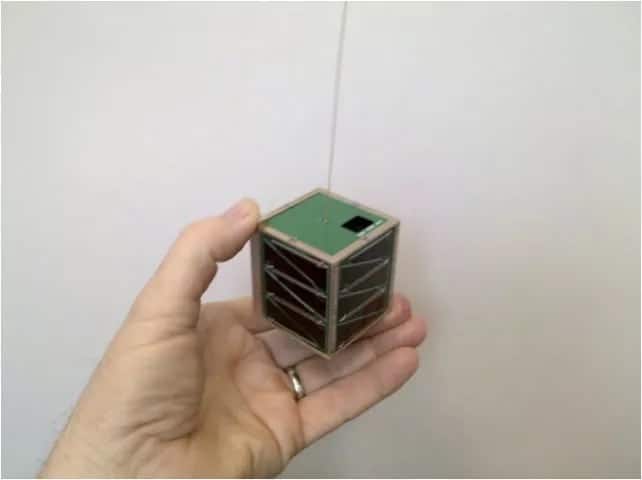There’s no doubt that exploring space and venturing into the unknown galaxies with advanced satellites is an enticing prospect! However, while it is believed that these expensive devices are only accessible by the likes of NASA and wealthy billionaires, it’s simply not true!
Civilians can own satellites, known as picosatellites, that resemble paperweights as they are so small and lightweight. Picosatellites are roughly an inch long, and their self-assembly kits contain computer-on-chip components, antennas, radio transmitters, sensors, power systems, and batteries.
Can Civilians Legally Own Private Satellites?
Owning a private satellite is no longer the exclusive privilege of wealthy governments and powerful corporations, as staggering technological advances have made it possible for civilians to own satellites.
Rapid advancements in satellite manufacturing technology have resulted in cheaper, simpler, and smaller devices that are now commercially available as DIY satellite building kits, which may even include affordable launching fees. Thus, owning a satellite is far more accessible than it was before.
What Type Of Satellites Can Civilians Own?
Although several private satellites have been on the market for numerous years, this was all brought about due to technological advancements in picosatellite designs.
Picosatellites are miniature, lightweight satellites with approximately inch-long dimensions containing all the communicative and electronic accessories needed to launch into space.
Several picosatellite brands are available on the market, equipped with antennas, radio transmitters to download data or for up-linking commands, computer-on-chip components, sensors, and power systems typically consisting of solar cells and batteries.
Which Privates Satellites Are The Best?
Even though various private companies and leading universities have designed their unique versions of picosatellites, most are CubeSats. So, what are they?
The term cube merely refers to the picosatellite’s cube shape, which may resemble a paperweight, and the most popular CubeSats, or “1U satellites,” have cube dimensions of approximately 4 inches.

CubeSats are practical as they can easily fit into the previously wasted space of launch vehicles due to their minuscule size. Several mini-satellites can be launched into space simultaneously.
And commercially produced, off-the-shelf CubeSat kits are widely available. Moreover, they can be assembled relatively easily and at a cost that is slowly starting to decline due to technological advancements.
However, while these CubeSat kits are readily available, finding a means of launching them into space is far more complex and expensive.
Can I Legally Launch My Own Satellite From The USA?
While civilians can legally build and own their own picosatellites, they need to consult with the Federal Communications Commission (FCC), including the Federal Aviation Administration (FAA) to determine whether they need a license to deploy it into space.
The FCC works in partnership with the FAA to issue licenses to commercial, private, and government departments to coordinate and manage all satellite launches, so it’s essential to consult with them before any private satellite launch.
However, only specific rocket launches require approval from the FCC and FAA.
Additionally, there are numerous variables to consider as rockets and payloads that weigh more than 3.3 lbs, including the weight of the fuel that may require FCC waivers, including satellite rockets that contain more than 125 grams.
Another prime consideration is where the satellite owner plans to launch it into space, primarily if the area is close to an airport. However, private satellite owners could partner with colleges or schools that have existing FCC and FAA licenses.
Can I Partner With A Company To Launch My Private Satellite?
While launching a private satellite can be daunting, several companies like Virgin Galactic and Rocket Lab are making it easier for the private sector to launch their CubeSats by entering partnerships with NASA.
However, it is essential to note that some private satellite launching companies charge more than $40,000, which can be a mere starting price in some instances.
Many competing companies have developed their own competitively priced versions of the popular CubeSat, with inclusive launching fees. An example is InterOrbital Systems (IOS), which developed the CubeSat a few years ago.
The CubeSat featured a lengthier hexagonal architecture and included all the major hardware and schematics in the picosatellite kit, all with a price range of $7,500-$8,000. However, this price depended on whether the buyer opted in for a launch option.
So, it’s clear that picosatellite kits and launching fees are becoming far more competitive as new players enter the market.
How Are Universities Developing Picosatellites?
Leading tertiary institutions like Arizona State University (ASU) have also made significant strides in researching and developing affordable personal satellites and have designed an innovative SunCube picosatellite that will become commercially available.
The university’s SunCube prototypes are all built with cheap off-the-shelf picosatellite components, which means that the public consumers could eventually launch their own satellite into the LOE for a mere $1,000 and, more excitingly to the ISS, or International Space Station, for only $3000.
There are two versions of the SunCube. The first smaller picosatellite weighs a mere 1.2 ounces. It has dimensions of roughly an inch in size and contains all the necessary components for communication to collect data, including a solar panel-powered propulsion system.
The larger SunCube picosatellite weighs roughly 3.5 ounces and provides additional space for experimentations and data storage.
Where Will Your Picosatellite Go?
Most picosatellites that are privately owned, and other artificial space objects end up in the low earth orbit (LEO), which orbits the earth roughly 11.25 times per day.
The LEO orbit is approximately 90-370 miles away from earth, which is part of its ionosphere, or magnetic field, and situated in the same orbital range as the International Space Station (ISS) and the Hubble Telescope.
So, why is the LEO orbit ideal for picosatellites? While there are numerous reasons, the orbit shields picosatellites from harmful sun rays that could wreck them. While there are no guarantees that these miniature satellites are safer in the low earth orbit, they are far more shielded in that region.
How Long Will A Picosatellite Last In LEO?
There’s no doubt that picosatellites are incredibly useful and fascinating, especially for private owners interested in star and earth observations or with a passion for cutting-edge science.
However, it’s important to remember that these miniature satellites have a relatively short lifespan as most picosatellites only remain operational for 3-16 short weeks or up to 2 years, after which they enter the earth’s atmosphere and burn up.
This self-destructive process starts when the picosatellites start breaking down when particles collide with them, and it starts slowing down to such an extent that it re-enters the earth’s atmosphere.
What About Space Debris?
Even though owning and launching a private satellite into space has become far more accessible for the public, it has become a hotly debated topic as space debris is increasing rapidly.
While technology is evolving, some CubeSats do not have onboard propulsion systems. Moreover, because most owners are obliged to use whatever launching option they have available as secondary payloads, they often can’t tell space regulators in which orbit their satellite will operate.
Orbital debris specialists must know where satellites will travel to calculate how long they will remain operational and when they will start to disintegrate and ultimately burn out.
In many instances, private satellite owners are faced with a dilemma as they need to either abort their secondary payload launch or accept that their picosatellite will remain in space for several decades after it has ceased operation.
References ▾
Related Posts














